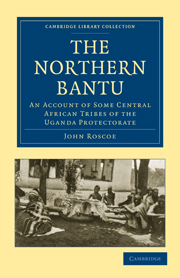Book contents
- Frontmatter
- PREFACE
- Contents
- LIST OF ILLUSTRATIONS
- Uganda and British East Africa
- PART I THE BANYORO A PASTORAL PEOPLE
- PART II THE BANYANKOLE A PASTORAL TRIBE OF ANKOLE
- PART III THE BAKENE, LAKE DWELLERS
- CHAP. XIV THE BAKENE, LAKE DWELLERS; SOCIOLOGY, GOVERNMENT, RELIGION, FISHING, BUILDING, DRESS AND ORNAMENTS
- PART IV THE BAGESU A CANNIBAL TRIBE
- PART V THE BASOGA
- PART VI NILOTIC TRIBES. THE BATESO AND THE KAVIRONDO
- INDEX
- PUBLICATIONS OF THE CAMBRIDGE UNIVERSITY PRESS RELATING TO AFRICA
- Plate section
CHAP. XIV - THE BAKENE, LAKE DWELLERS; SOCIOLOGY, GOVERNMENT, RELIGION, FISHING, BUILDING, DRESS AND ORNAMENTS
Published online by Cambridge University Press: 07 September 2011
- Frontmatter
- PREFACE
- Contents
- LIST OF ILLUSTRATIONS
- Uganda and British East Africa
- PART I THE BANYORO A PASTORAL PEOPLE
- PART II THE BANYANKOLE A PASTORAL TRIBE OF ANKOLE
- PART III THE BAKENE, LAKE DWELLERS
- CHAP. XIV THE BAKENE, LAKE DWELLERS; SOCIOLOGY, GOVERNMENT, RELIGION, FISHING, BUILDING, DRESS AND ORNAMENTS
- PART IV THE BAGESU A CANNIBAL TRIBE
- PART V THE BASOGA
- PART VI NILOTIC TRIBES. THE BATESO AND THE KAVIRONDO
- INDEX
- PUBLICATIONS OF THE CAMBRIDGE UNIVERSITY PRESS RELATING TO AFRICA
- Plate section
Summary
The district of the Bakene. The district to which the Bakene belong has necessarily a limited area, because their mode of life, together with their staple article of food, restricts them to the few stretches of water in which papyrus-grass grows freely; for that grass forms the foundation for their floating houses, and is also the chief material used in building them, while fresh water fish is their principal article of food. Hence the sources of the Nile and its feeders are the home of these people and their domain is one of water rather than of land. Their houses are to be found either on the floating roots of papyrus on the sunny waters of small lakes or in the forestlike growth of papyrus on the rivers flowing into the Nile.
Floating houses. The Bakene are a small Bantu tribe dwelling in floating huts on the Mpologoma river, on Lake Kyoga, on Lake Salisbury, and I believe also on Lake Rudolf: they cannot exceed three thousand in number.
Lake Kyoga and Mpologoma River the homes of the Bakene. The River Mpologoma rises on Mount Elgon, runs for some miles in a southerly direction, then winds to the west and rapidly widens until it empties itself into Lake Kyoga. The water of the river is held up by the enormous growth of papyrus and spreads over a vast area, in some places several miles wide; the current is sluggish, almost imperceptible, and it is only where the river narrows that the flow is discernible: there is no great depth at any place.
- Type
- Chapter
- Information
- The Northern BantuAn Account of Some Central African Tribes of the Uganda Protectorate, pp. 145 - 158Publisher: Cambridge University PressPrint publication year: 2010First published in: 1915



